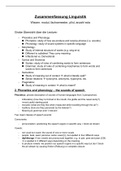Summary
Summary Introduction to Linguistics
- Course
- Institution
The summary consists of a few explanations of terms, many examples, explanations and a few illustrations and provides a good overview of the introductory lecture “Introduction to Linguistic.”
[Show more]



